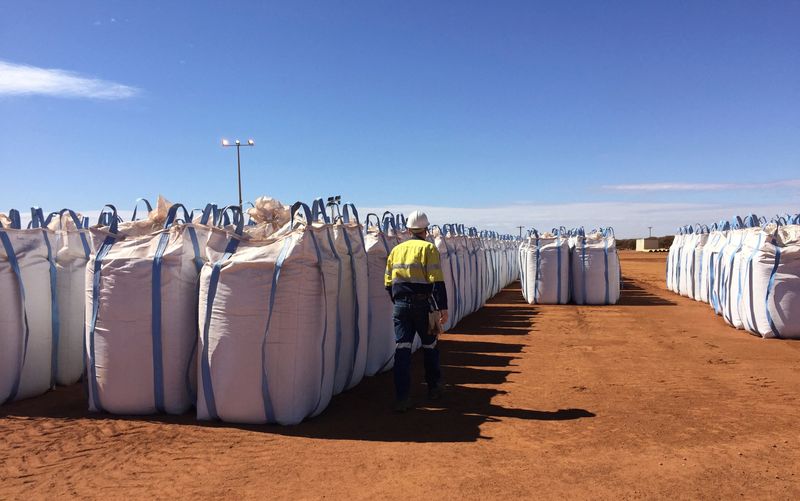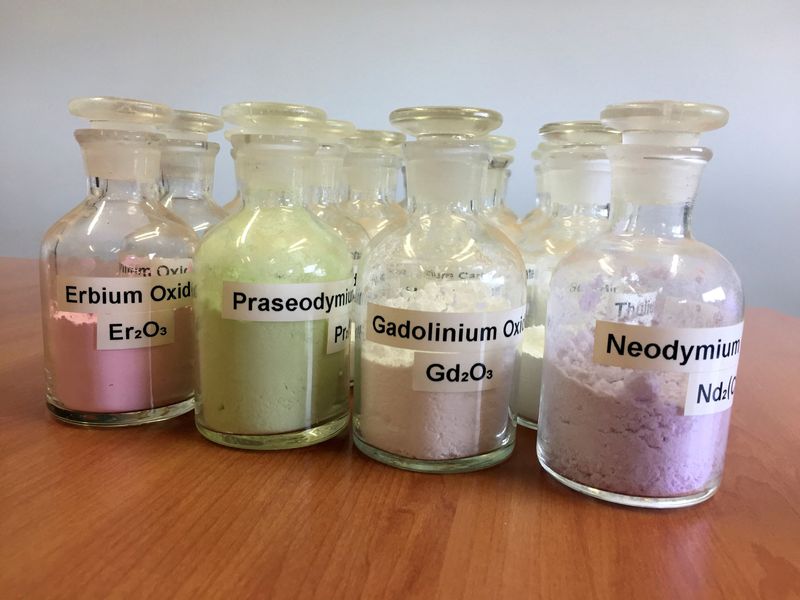By Melanie Burton and Fabio Teixeira
MELBOURNE/RIO DE JANEIRO (Reuters) - Mining giant Brazil has big ambitions to build a rare earths industry as Western economies push to secure the metals needed for magnets used in green energy and defence and break China's dominance of the supply chain.
Working to its advantage are low labour costs, clean energy, established regulations and proximity to end markets, including Latin America's first magnet plant which would provide a ready buyer for the metals.
But low rare earths prices, technical challenges and nervous lenders pose challenges to the Latin American nation's hopes to propel itself into the world's top five rare earths producers.
The pace at which Brazil's rare earths projects come together will be a test for how successful the West may be at building a new advanced industry almost from scratch to break China's grip.
Brazil holds the world's third-largest rare earth reserves. The country's first rare earths mine, Serra Verde, started commercial production this year.
Output is set to grow, analysts, mining CEOs and investors say, supported by Western government incentives that are also accelerating a global rare earths refining and processing industry.
"Brazil as a source of potential rare earths is a very exciting proposition because there have been some very meaningful discoveries made in the past couple of years," said Daniel Morgan of Barrenjoey investment bank in Sydney.
"I do think outside of China, Brazil’s projects are the most economic greenfield projects available."
The U.S. and its allies, almost entirely dependent on China for rare earths metals and magnets, set out to build a separate supply chain by 2027 after deliveries were disrupted during the COVID-19 pandemic early this decade.
LONG HAUL
China produced 240,000 metric tons of rare earths last year, more than five times the next biggest producer, the United States, according to U.S. Geological Survey data. It processes around 90% of the global supply of rare earths into permanent magnets used in everything from wind turbines to electric vehicles and missiles.
For countries like Australia, Vietnam and Brazil looking to catch up, progress is slow. Serra Verde has taken 15 years to get into production. It is expected to produce 5,000 tons once ramped up and could double output by 2030, its CEO said.
"Serra Verde and Brazil have significant competitive advantages that could underpin the development of a globally significant rare earths industry over the long term," Serra Verde CEO Thras Moraitis told Reuters.
Those include attractive geology, access to hydropower, established regulations and a skilled workforce, he said.
"It is still a nascent sector which will require continued support to establish itself in a highly competitive market. Key processing technologies are controlled by a small number of players," he said.
Brazil could have two or three more rare earths mines by 2030, potentially exceeding Australia's current annual output, said Reg Spencer, an analyst at broker Canaccord.
BASEMENT PRICES
One major obstacle is a 70% slump in rare earths prices over the past two years that has made it difficult for companies to raise funds for mines and processing.
"Getting money at the moment is tough," Nick Holthouse, chief executive of Australian-listed developer Meteoric Resources, told Reuters.
Meteoric is targeting an investment decision in late 2025 for its Caldeira project in Brazil’s Minas Gerais state which will produce light and heavy rare earths.
In March, the U.S. Export-Import Bank (EXIM) expressed interest in providing Meteoric up to $250 million for the project. The company also has a preliminary deal to supply rare earth oxides to a separation plant in Estonia run by Toronto-listed Neo Performance Materials.
Brazilian Rare Earths, too, is in the early stages of developing a large rare earths deposit in the country's northeast, backed by Australia's richest person, Gina Rinehart.
Its CEO, Bernardo Da Veiga, highlighted Brazil's low operating costs as an advantage over rivals like Australia, where he said a truck driver at an iron ore mine would earn up to A$200,000 ($133,200) a year plus food and accommodation.
"That same truck driver in Brazil, doing the same job, earns like $15,000 a year and he rides his bike to work and brings his lunch. There's just no comparison."
COMPLEXITIES
While labour is cheap, developers face technical hurdles. Unlike in China, many Western companies are still perfecting the complex processes for producing rare earth metals, a costly challenge that has stalled projects for years.
To spur developments, the Brazilian government launched a 1 billion reais ($194.53 million) fund in February to finance strategic minerals projects, including rare earths.
It also wants to build an industry for transforming these minerals into alloys for batteries, wind turbines and electric motors, the Ministry of Mines and Energy said in a statement.
The challenge is to stimulate production and build partnerships to promote element separation technologies and supply chain development, the ministry said. It is also looking into rare earths recycling.
Among companies talking to the government about recycling technology is Australia's Ionic Rare Earths (ASX:IXR), which has a pilot recycling plant in Belfast and a tie up with Brazilian developer Viridis Mining and Minerals, its CEO Tim Harrison said.
Brazil is also building a magnet factory due to start operating later this year as a proof of concept, Flavio Roscoe, president of Minas Gerais' state Federation of Industries (FIEMG) said.
"Our objective is to be a developer, a multiplyer of this technology," Roscoe said.
"Brazil has the opportunity to be the world's option to China."

($1 = 1.5015 Australian dollars)
(This story has been corrected to clarify that Serra Verde will produce 5,000 tons of rare earth oxides once ramped up, not this year, in paragraph 11)
